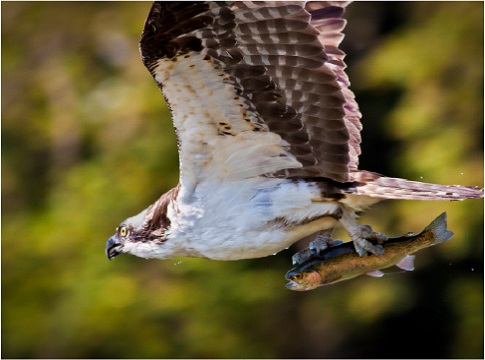Ospreys feed almost exclusively on fish and that means nesting close to rivers and lakes. Additionally, ospreys prefer a nest with a view—the tallest and least-obstructed power pole will do nicely. EWEB has approximately 3,200 poles within a quarter-mile of the McKenzie and Willamette rivers, and that requires a proactive approach to accommodating these tenacious nest-builders.

Protecting osprey and preventing power outages
Osprey nests built atop power poles can cause fires and outages, as well as increase electrocution risk for the birds. Complicating the problem is that the birds remain committed to their nest site year after year, which can lead to very large nests that exceed the weight capacity of the pole and create an unstable nest.
Those nests can also accumulate plastic debris, such as fishing line, that presents an entanglement hazard to the birds. In 2013, a baby osprey became tangled in fishing line and was rescued by EWEB crews and Cascade Raptor Center staff after falling from its nest.
To protect the birds and reduce the risk of electrical outages, EWEB electric crews and environmental staff regularly monitor and evaluate nests.
Elements of EWEB's Osprey Protection Program include:
- Tracking bird-related outages and bird mortalities
- Assessing and managing nests on utility structures
- Taking corrective and preventive measures to reduce injuries, mortalities, and outages
- Training field crews on protocols for identifying problem nests
We have many tools to manage our electrical system and accommodate safe use by osprey.
If a nest is determined to be at risk, EWEB manages the nest in accordance with state and federal laws. Corrective and preventive measures might include removing uninhabited nests, cleaning out nests to reduce their size, relocating nests, installing goose decoys as deterrents, or building nesting platforms.

As of 2020, EWEB has built 30 osprey nesting platforms throughout our service territory, some on existing power poles and some as standalone structures. During our most recent annual assessment, we found that 22 of the platforms are actively in use.
Osprey Watch
Help EWEB protect osprey and prevent power outages by reporting osprey nests on power poles.
To report a nest, email us and include the following information:
- The pole number, located on a placard near eye level on the pole (only if the pole is easily and safely accessible)
- The nearest address to the pole
When EWEB receives a report of a nest, crews follow all federal and local wildlife regulations while assessing whether the nest is inhabited and if it can be removed or relocated.
Osprey Facts
- The osprey is a large hawk, sometimes referred to as a fish hawk or sea hawk
- They feed primarily on live fish, but they will sometimes catch and eat a snake, eel or even a frog
- Females lay one to four eggs in the spring
- Nests are often used year after year
- After generations of adding to the nest year after year, Ospreys can end up with nests 10-13 feet deep and 3-6 feet in diameter
- Nesting period is March - September
- Osprey migrate to Central America to winter between October-February
- Osprey populations plummeted in the 1960s due to DDT-induced eggshell thinning
- Populations have flourished since the Environmental Protection Agency banned DDT in 1972
For more information about osprey and power poles, check out this article published by the Audubon Society: As Ospreys Recover, Their Nests Are Sparking Fires and Power Outages
Photo credit: Pictures of osprey in flight with fish in talons, and osprey against the blue sky were taken by local photographer Quentin Furrow at Alton Baker Park.

